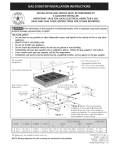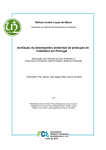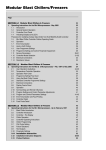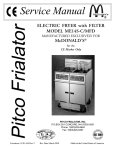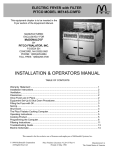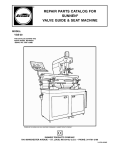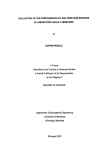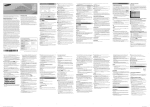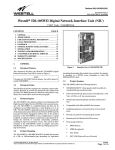Download Cowon CR1 Operating instructions
Transcript
TM 11-6625-333-15 TECHNICAL MANUAL OPERATOR’S, ORGANIZATIONAL, DIRECT SUPPORT, GENERAL SUPPORT, AND DEPOT MAINTENANCE MANUAL STANDING-WAVE-RATIO POWER METER ME-165/G (NSN 6625-00-682-4464) This copy is a reprint which includes current pages from HEADQUARTERS, Changes 1 through 3. DEPARTMENT OF THE ARMY MARCH 1971 The following are general safety precautions that are not related to any specific procedure and, therefore, do not appear elsewhere in this publication. These are recommended precautions that personnel must understand and apply during many phases of operation and maintenance. Operator and maintenance personnel should be familiar with the safety requirements before attempting installation or operation of the equipment covered by this manual. Failure to follow requirements and observe safety precautions could result in injury or damage to the equipment. For the successful execution of methods of equipment destruction involving the use of demolition materials, all personnel should become thoroughly familiar with the pertinent provisions of FM 5-25. *TM 11-6625-333-15 T ECHNICAL M A N U A L HEADQUARTERS DEPARTMENT OF THE ARMY W ASHINGTON , DC 5 March 1971 No. 11-6625-333-15 OPERATORS, ORGANIZATIONAL, DIRECT SUPPORT, GENERAL SUPPORT AND DEPOT MAINTENANCE MANUAL STANDING-WAVE-RATIO POWER METER ME-165/G (NSN 6625-00-682-4464) REPORTING ERRORS AND RECOMMENDING IMPROVEMENTS You can help improve this manual. If you find any mistakes or if you know of a way to improve the procedures, please let us know. Mail your letter, DA Form 2028 (Recommended Changes to Publications and Blank Forms), or DA Form 2028-2 located in back of this manual direct to: Commander, US Army Communications and Electronics Materiel Readiness Command, ATTN: DRSEL-ME-MQ, Fort Monmouth NJ 07703. In either case, a reply will be furnished direct to you. Table of Contents C HAPTER 1 . 2. C HAPITER 3. SECTION I. II. C HAPTER 4. C HAPTER 5 . SECTION I. II. C HAPTER 6 . 7. A PPENDIX A . B. C. IN D E X Paragraph Page INTRODUCTION 1.1 - 1-5 1-1 INSTALLATION AND OPERATING INSTRUCTIONS 2-1 - 2-4 2-1 OPERATOR AND ORGANIZATIONAL MAINTENANCE Operator maintenance.. . . . . . . . . . . . . . . . . . . . . . . . . . . . . . . . . . . . . . . . . . . . . . . . . . . . . . . . . . . . . . . .. . . . . . . . . 3-1 - 3-8 3-1 O r g a n i z a t i o n a l m a i n t e n a n c e. . . . . . . . . . . . . . . . . . . . . . . . . . . . . . . . . . . . . . . . . . . . . . . . . . . . .3.9 - 3-12 3-3 DIRECT AND GENERAL SUPPORT MAINTENANCE . . . . . . . . . . . . . . . . . . . . . . . . . . . . . . . . ..4-1 - 4-6 4-1 DEPOT MAINTENANCE AND DEPOT OVERHAUL STANDARDS D e p o t m a i n t e n a n c e . . . . . . . . . . . . . . . . . . . . . . . . . . . . . . . . . . . . . . . . . . . . . . . . . . ... . . . ..5-1, 5-2 5-1 Depot overhaul standards . . . . . . . . . . . . . . . . . . . . . . . . . . . . . . .. . . . . . . . . . . . . . . . . . . . . . . . . . . . . . ..5-3 - 5-6 5 - 1 FUNCTIONING OF EQUIPMENT . . . . . . . . . . . . . . . . . . . . . . . . . . . . . . . . . . . . . . . . . . . . . . . . . . . . . ..6-1, 6-2 6-1 STORAGE AND DEMOLITION OF EQUIPMENT . . . . . . . . . . . . . . . . . . . . . . . . . . . . . . . . . . . . . ..7-1 -7-6 7 - 1 REFERENCES . . . . . . . . . . . . . . . . . . . . . . . . . . . . . . . . . . . . . . . . . . . . . . . . . . . . . . . . . . . . . . . . . . . . . . . . . . . . . . . . . . . ..A-1 BASIC ISSUE ITEMS LIST (BIIL) AND ITEMS TROOP INSTALLED OR AUTHORIZED LIST (ITIAL) (Not Applicable) MAINTENANCE ALLOCATION . . . . . . . . . . . . . . . . . . . . . . . . . . . . . . . . . . . . . . . . . . . . . . . . . . . . . . . . . . . . . . . . . . ..C-1 . . . . . . . . . . . . . . . . . . . . . . . . . . . . . . . . . . . . . . . . . . . . . . . . . . . . . . . . . . . . . . . . . . . . . . . . . . . . . . . . . . . . . . . . . . . . . . . . . . . . . . I-1 This manual supersedes TM 11-809-10, 14 May 1958 including all changes, TM 11-809-20, 2 July 1958 and TM 11-809-35, 3 December 1958 as pertains to subject equipment. C h a n g e 2 i TM 11-6625-333-15 CHAPTER 1 INTRODUCTION 1-1. Scope This manual describes Standing-Wave-Ratio Power Meter ME-165/G (fig. 1-1) and covers installation, operation, and maintenance instructions. Appendix A contains a list of publications applicable to this manual and Appendix C contains the maintenance allocation chart. 1-2. Indexes of Publications a. DA Pam 310-4. Refer to the latest issue of DA Pam 310-4 to determine whether there are new editions, changes, or additional publications pertaining to the equipment. b. DA Pam 310-7. Refer to DA Pam 310-7 to determine whether there are modification work orders (MWO’s) pertaining to the equipment. 1-3. Maintenance Forms, Records, and Reports a. Reports of Maintenance and Unsatisfactory E q u i p m e n t . Department of the Army forms and procedures used for equipment maintenance will be those described by TM 38-750, The Army Maintenance Management System. b. Report of Packaging and Handling Deficiencies. Fill out and forward DD Form 6 (Packaging Improvement Report) as prescribed in AR 70058/NAVSUPINST 4030.29/AFR 71-13/MCO P4030.29A and DLAR 4145.8. c. Discrepancy in Shipment Report (DISREP) (SF 361). Fill out and forward Discrepancy in Shipment Report (DISREP) (SF 361) as prescribed in AR 55-38/NAVSUPINST 4610.33B/AFR 75-18/ MCO P4610.19C and DLAR 4500.15. 1-3.1. Reporting Equipment Improvement Recommendations (EIR) If your Standing-Wave-Ratio Power Meter ME165/G needs improvement, let us know. Send us an EIR. You, the user, are the only one who can tell us what you don’t like about your equipment. Let us know why you don’t like the design. Tell us why a procedure is hard to perform. Put it on an SF 368 (Quality Deficiency Report). Mail it to Commander, US Army Communications and Electronics Materiel Readiness Command, ATTN: DRSEL- ME-MQ, Fort Monmouth, NJ 07703. We’ll send you a reply. 1-3.2. Administrative Storage Administrative storage of equipment issued to and used by Army activities shall be in accordance with TM 740-90-1. 1-3.3. Destruction of Army Electronics Materiel Destruction of Army electronics materiel to prevent enemy use shall be in accordance with TM 750-244-2. 1-4. Description of Standing-Wave Ratio Power Meter ME-165/G a. The ME-165/G is used for measuring transmitter output power and standing-wave-ratio; it may also be used for terminating the transmitter during radio silence operation. b. All components of the ME-165/G are mounted on the front panel which fastens into a louvered case with 10 screws. The rear of the case has a flange on top and a bracket on the bottom to permit wall mounting (fig. 1-2). c. The unit is 13-1/2 inches by 9-5/8 inches by 9-5/8 inches, and has a gray, smooth finish. A wingnut on the bottom of the case secures a ground braid. 1-4.1. Component Comprising the Operable End Item Standing Wave Ratio-Power Meter ME-165/G (FSN 6625-682-4464) comprises the operable end item. 1-5. Differences in Equipments a. Standing-Wave-Ratio Power Meters ME165/G, procured on Order Numbers 3219-Phila.-59 and 3241-Phila.-59, are similar in appearance, operation, and purpose to those procured on previous orders. They differ only in some piecepart reference designations which are outlined in the chart below: NOTE All reference designations not listed in the chart are identical for all units. Change 2 1-1 Change 1 TM 11-6625-333-15 1-2 Figure 1-1. TM 11-6625-333--15 Figure 1-2. Standing-Wave-Ratio Power Meter ME-165/G mounted on wall of shelter. All orders prior to No. 3219-PP-59 Order No. 3219-PP-59 and 3241-PP-59 Component C3 C4 C5 C6 C7 C8 C9 C10 CR1 CR2 R13 R14 R15 R16 R17 Component C4 C5 C6 C7 C8 C1 C2 C3 CR2 CR1 R20 R21 R13 R22 R23 All orders prior lo No. 3219-PP-59 Order No. 3219-PP-59 and 3214-PP-59 Component R18 R19 R20 R21 R22 R23 Component R14 R15 R16 R17 R18 R19 b. Standing-Wave-Ratio Power Meter ME-165/G procured on Numbers Order 3219-PP-59 and 3241-PP-59 indicate powcr on the upper meter scale and SWR on the lower scale; those procured on other order numbers indicate power on the lower meter scale and standing wave ratio on the upper meter scale. 1-3 TM 11-6625-333-15 CHAPTER 2 INSTALLATION AND OPERATING INSTRUCTIONS NOTE The ME-l65/G is designed as a ready-to-go equipment; therefore, detailed unpacking procedures do not apply. 2-1. Checking Unpacked Equipment a. Inspect the equipment for damage that may have been incurred during shipment. If the unit has been damaged, fill out and forward DD Form 6. b. Check to see that the equipment is complete as Iisted on the packing slip. Report all discrepancies in accordance with TM 38-750. NOTE Shortage of a minor assembly or part that does not affect proper functioning of the equipment should not prevent use of the equipment. c. If the equipment has been used or reconditioned, check to see whether it has been changed by a modification work order (MWO). If the equipment has been modified, the MWO number should appear on the front panel near the nomenclature plate. Check to see whether the MWO number (if any) and appropriate notations concerning the modifications have been written into the equipment manuals. NOTE Current MWO’s applicable to the equipment are listed in DA Pam 310-7. 2-2. Controls and Indicators (fig. l-l) The designation and function of the various controls and indicators of the ME-165/G are described in the chart below. Function Control or indicator POWER . . . . . . . Connects transmitter power output to dummy load; power output of transmitter is indicated on meter. Control or indication Function ADJUST . . . . . . . . Used in conjunction with ADJUST rotary control to calibrate m e t e r f o r v s w r measurements. SWR . . . . . . . . . . . . . . . . . . . . . . . . .Used to indicate vswr between transmitter and its load. OPERATE. . . . . . . . . . . Connects power output of transmitter directly to load. ADJUST rotary control . . Used in conjunction with function switch to calibrate meter for vswr measurements. INPUT connecter . . . . Used as conception for amplifier input. OUTPUT connector . . . . . Used to apply rf output to radio set antenna. METER . . . . . . . . . . . . . . . Provides visual indication of average output power in watts, or vswr depending on position of function switch. 2-3. Tuning Procedures CAUTION If the transmitting antennas of two or more radio sets are close together, coordinate tuning operations so that one radio set is not transmitting while the function switch of the ME-165/G in the other radio set is set to SWR. Power radiated from a nearby antenna can burn out the dummy load resistor in the ME-165/G. a. Place the ME-165/G function switch at POWER b. Tune and load the transmitter in accordance with standard operating procedures. c. Note that the ME-165/G indicates the transmitter power output. Change 1 2-1 TM 11-6625-333-15 When the function switch is set to POWER, ADJUST, or SWR, full transmitter output power is dissipated in the dummy load of the ME-165/G. Do not apply power continuously for longer than 10 minutes or the unit may be damaged. h. Set the function switch to OPERATE to connect the output of the transmitter directly to the antenna tuning unit. 2-4 Operational Procedures d. S e t t h e M E - 1 6 5 / G f u n c t i o n s w i t c h t o ADJUST. Since the ME-165/G can be operated in various modes, the particular mode of operation and the average power indications to be observed are as follows : e. Rotate the ADJUST rotary control to obtain a full-scale indication. a. Continuous wave (cw) _ Approximately 200 watts. NOTE Do not keep the control in the ADJUST position any longer than necessary for meter adjustment. f. Set the function switch to SWR. g. Observe that the proper standing wave ratio between the transmitter and tuning unit is reflected on the upper scale (green area) of the meter. 2-2 Change 1 b. Single sideband (ssb) _ _ Approximately 200 watts. c. Compatible amplitudemodulated (am. ) Approximately 200 watts. d. Frequency shift keying Approximately 200 watts. (fsk) e. Voice plus fsk _ _ _ _ _ _ _ _ Approximately 100 watts. TM 11-6625-333-15 CHAPTER 3 OPERATOR AND ORGANIZATIONAL MAINTENANCE Section I. OPERATOR MAINTENANCE 3-1. Scope of Operator Maintenance The maintenance duties assigned to the operator of the ME-165/G are listed below together with a reference to the paragraphs covering the specific maintenance function. a. Daily preventive maintenance checks and services (para 3-5). b. Cleaning (para 3-6). c. Troubleshooting (para 3-7). d. Touchup painting (para 3-8). 3-2. Tools, Materials, and Test Equipment Required The only tools and test equipment required for operator maintenance are those furnished as part of the ME-165/G. The required materials are as follows : a. Trichloroethane. b. Cloth, textile: cheesecloth, lint-free (FSN 8305-267-3015). c. Abrasive sheet (FSN 5350-271-7939). 3-3. Operator Preventive Maintenance tematic care and cleaning essential to proper upkeep and operation of the equipment. b. Preventive Maintenance Checks and Services. The preventive maintenance checks and services chart (para 3-5) outlines functions to be performed at specific intervals. These checks and services are to maintain electronic equipment in a combat-serviceable condition; that is, in good general (physical) condition and in good operating condition. To assist operators in maintaining combat serviceability, the chart indicates what to check, how to check, and the normal conditions; the References column lists the illustrations, paragraphs, or manuals that contain detailed repair or replacement procedures. If the defect cannot be remedied by the operator performing the corrective actions listed, higher category maintenance or repair is required Records and reports of these checks and services must be made in accordance with the requirements given in TM 38-750. 3-4. Preventive Maintenance Checks and Services Periods Preventive maintenance checks and services of the ME-165/G are required daily by the operator. Paragraph 3-5 specifies the checks and services that must be accomplished daily and under the conditions listed below: Preventive maintenance is the systematic care, servicing, and inspection of equipment to prevent the occurrence of trouble, to reduce downtime, and to assure that the equipment is serviceable. b. When the equipment is reinstalled after removal for any reason. a. Systematic Care. The procedures given in paragraphs 3-4 through 3-8 cover routine sys- c. At least once each week if the equipment is maintained in standby condition. a. When the equipment is initially installed. 3-5. Operator Daily Preventive Maintenance Checks and Services Chart Item to be inspected Procedure References 1 Completeness . . . . . . . . . . . . . . . . . . . . . . . . Check to see that equipment is complete. App B. 2 Exterior surfaces . . . . . . . . . . . . . . . . . . . Clean exterior surfaces of equipment_ _ _ _ _ 3 Connectors . . . . . . . . . . . . . . . . . . . . . . . . Sequence No. Check tightness of all power connectors. Fig. 1-1. Fig. 1-1. 3-1 TM 11-6625-333-15 3-5. Operator Daily Preventive Maintenance Checks and Services Chart (cont.) Sequence 4 5 6 7 8 No. Item to be inspected Procedure Signal cables and wires . . . . . . . . . . . . . . . . . . Inspect cables for fraying or damaged insulation. Inspect for defective connections with strained wires. Tighten any loose plugs and connections. mechanical action of each jack by inserting a Jacks . . . . . . . . . . . . . . . . . . . . . . . . . . . . . . . . . . .Inspect . plug. Hardware . . . . . . . . . . . . . . . . . . . . . . . . . . . . . . .Make sure that all threaded hardware is not nicked, burred, or otherwise marred. Controls and indicators . . . . . . . . . . . . . . . . . While making the operating checks (sequence No. 8), observe that mechanical action of each knob, dial, and switch is smooth and free of external or internal binding and that no excessive looseness exists. Operation . . . . . . . . . . . . . . . . . . . . . . . . . . . . . . .Operate equipment according to appropriate instructions. Report any operational failure of equipment. Replace defective items for which running spares are authorized. 3-6. Cleaning Inspect the exterior of the equipment. The exterior surfaces should be clean, and free of dust, dirt, grease, and fungus. a. Remove dust and loose dirt with a clean, soft cloth. Adequate ventilation should be provided TRICHLOROTRIFusing while LUOROETHANE. Prolonged breathing of vapor should be avoided. The solvent should not be used near heat or open flame; the products of decomposition are toxic and irritating. Since TRICHLOROTRIFLUOROETHANE dissolves natural oils, prolonged contact with skin should be avoided. When necessary, use gloves which the solvent cannot penetrate. If the solvent is taken internally, consult a physician immediately. b. Remove grease, fungus, and ground-in dirt from the equipment case; use a cloth dampened (not wet) with trichloroethane. c. Remove dust or dirt from plugs and jacks with a brush. CAUTION Do not press on the meter face (glass) when cleaning, the meter may become damaged. d. Clean the front panel, meter, and control knobs with a soft, clean cloth. If dirt is difficult to remove, 3 - 2 Change 2 References Fig. 1-1 dampen the cloth with water; mild soap may be used for more effective cleaning. e. Remove dust from around terminal boards and other small components by using a properly shaped brush to loosen the accumulation. If available, dry compressed air may be used at a line pressure not to exceed 60 pounds-per-square inch (psi) to remove dust from inaccessible places; however, be careful or mechanical damage from the airblast may result. 3-7. Operator Troubleshooting Whenever an equipment trouble occurs, make a visual inspection of all equipment controls and cable connections before performing any detailed troubleshooting procedures. The following visual checks should be made by the operator to determine the possible cause of malfunction. a. Check all equipment controls for proper positioning. b. If necessary, check to see that all signal and power cable arrangements are correctly located and secure. c. Perform other visual checks as indicated in the appropriate technical manuals (app A). d. If the trouble is not apparent, or the above checks do not reveal the cause of malfunctioning, higher category maintenance is required. 3-8. Touchup Painting Instructions Clean rust and corrosion from metal surfaces by lightly sanding them with fine sandpaper. Brush TM 11-6625-333-15 two thin coats of paint on the bare metal to protect it from further corrosion Refer to the Section II. applicable cleaning and refinishing practices specified in TB 746-10. ORGANIZATIONAL MAINTENANCE 3-9. Organizational Preventive Maintenance a. Preventive maintenance is the systematic care, inspection, and servicing of equipment to maintain it in serviceable condition, prevent breakdowns, and assure maximum operational capability. Preventive maintenance is the responsibility of all categories of maintenance concerned with the equipment and includes the inspection, testing, and repair or replacement of parts, subassemblies or units that inspection and tests indicate would probably fail before the next scheduled periodic service. Preventive maintenance checks and services of the equipment at the organizational category of maintenance are made at monthly intervals unless otherwise directed by the commanding officer. The preventive maintenance checks and services should be scheduled concurrently with the periodic service schedule of the carrying vehicle for all vehicular installations. b. Maintenance forms and records to be used and maintained on this equipment are specified in TM 38-750. 3-10. Monthly Maintenance Perform the maintenance functions indicated in the monthly preventive maintenance checks and services chart (para 3-11) once each month. A month is defined as approximately 30 calendar days of 8-hour-per-day operation. If the equipment is operated 16 hours a day, the monthly preventive maintenance checks and services should be performed at 15-day intervals. Adjustment of the maintenance interval must be made to compensate for any unusual operating conditions. Equipment maintained in a standby (ready for immediate operation) condition must have monthly preventive maintenance checks and services performed on it. Equipment in limited storage (requires service before operation) does not require monthly preventive maintenance. 3-11. Organizational Monthly Preventive Maintenance Checks and Services Chart Sequence Item to be inspected No. References Procedure 1 Publications Check to see that all publications are complete, serviceable, and current. DA PAM 310-4. 2 Modifications Check DA Pam 310-7 to determine if new applicable MWO’s have been published. All URGENT MWO’s must be applied immediately. All NORMAL MWO’s must be scheduled. DA Pam 310-7 and TM 38-7 App A and B. 3 Spare parts Check all spare parts (operator and organizational) for general condition and method of storage. No overstock should be evident and all shortages must be on valid requisitions. 4 Equipment hardware Tighten loose bolts, nuts, and screws that hold equipment. Replace missing bolts, screws, nuts, and washers. Replace all badly burred screws, bolts, and nuts which cannot be engaged or turned with a screwdriver or wrench. 5 Signal and power cables and cords _ _ _ _ _ _ Dress all cables and cords neatly. 6 Miscellaneous items Check to see that all items not required for immediate use are properly stored. 7 Cable layout Inspect cable layout and relocate cables as necessary so that they are not endangered by, and are not dangerous to personnel. 50. 3-3 TM 11-6625-333-15 Sequence No. 8 Item to be inspected Resistors and capacitors _ _ _ _ _ _ _ _ Procedure Inspect for cracks, blistering, or other detrimental defects. Inspect variable capacitors for dirt, corrosion, or defor- References Fig. 4-2 and 4-3. med plates. 3-12. Organizational Troubleshooting Information The troubleshooting and repair work that can be performed at the organizational category of maintenance is necessarily limited in scope by the 3-4 tools, test equipment, and replaceable parts issue, and by existing tactical situation. Accordingly, troubleshooting is based on the performance of the equipment and the use of the senses in deterlining such troubles as burned out components and loose connections. TM 11-6625-333-15 CHAPTER 4 DIRECT AND GENERAL SUPPORT MAINTENANCE 4-1. General Maintenance Instructions a. The preventive maintenance procedures performed at direct and general support categories of m a i n t e n a n c e a r e actions w h i c h h a v e b e e n designed to anticipate potential problem areas for the purpose of correcting a possible trouble before it results in equipment outage. The action to be taken consists mainly of the following: (1) Visual inspection of the equipment for the purpose of determining general condition, unusual noise, and wear, and observing meter indications. Generaily, the equipment will remain operational when these inspections are made. (2) Repair or replacement of parts that have a definite life expectancy b. The direct and general support maintenance procedures are not complete in themselves but supplement the procedures performed at the organizational category and include any additional techniques required to perform maintenance cm the ME-165/G 4-2. Took, Materials, and Test Equipment Required a. The test equipment and materials required for maintenance of the ME-165/G are listed in the appropriate paragraphs in which the adjustment procedures are given. The specified test equipment, or suitable equivalents, should be used to comply with the requirements of this chapter. across high-voltage circuits. Severe burns or electrical shock to the user and damage to the equipment under test may result. 4-3. Troubleshooting Techniques To be effective, troubleshooting must be systematic; it will be necessary to perform a sequence of operational checks, observations, and measurements before the cause of a trouble is revealed. a. The first step in servicing a defective equipment is to sectionalize the fault. Sectionalization means tracing the fault to the major equipment component. The second step is to localize the fault. Localization means tracing the fault to the defective stage. The third step, isolation, means tracing the fault to the defective part. Some faults, such as burned-out resistors, can often be isolated by sight, smell, or hearing. The majority of faults, however, must be isolated by checking voltages, resistance, and signal levels b. After the trouble has been sectionalized, perform operational tests on the suspected section; figure 4-1 illustrates the test setup. Operational tests serve as a check of the sectionalizing test, and may also be used to indicate whether or not the unit is functioning properly. 4-4. Troubleshooting Procedures NOTE Before using the test equipment, carefully read the operating instructions. For maximum accuracy in all measurements, use the range that will produce a meter indication as close to midscale as possible. a. Localizing troubles to a defective part or circuit in the ME-165/G is accomplished at direct and general support categories of maintenance by performing the bench test described in d b e l o w until an abnormal condition is observed, noting the trouble symptom, and performing the related checks and corrective measures indicated in the troubleshooting chart (d b e l o w ) . h. When using test equipment, place it on a firm support and position the test equipment so that its controls are within easy reach. NOTE The ME-165/G must be recalibrated after any repairs or adjustments, D o N o t allow any test lead to drape b. B e n c h t r o u b l e s h o o t i n g requires the following: the ME-165/G 4-1 TM 11-6625-333-15 (1) 28-volt direct current (dc) power source to power a radiofrequency (rf) power source. (2) Telegraph key KY-116/U,or equivalent. (3) A 51-ohm, ½-watt composition resistor, (4) Wattmeter AN/URM-120. (5) Necessary cable assemblies (such as, Radio Frequency Cable Assembly CG-2340A/U, or CG-2568A/U) to connect the equipment. c. Connect the equipment as shown in figure 4-1 and perform the following: (1) Set the ME-165/G function switch to POWER. (2) Adjust the transmitter for cw operation at the lowest transmitting frequency. (3) Key the transmitter. (4) Compare the power indication on the ME-165/G with the power indication on the AN/ URM-120; the indications should agree within 10 percent. Trouble symptom (5) Adjust the transmitter for cw operation At the highest transmitting frequency. (6) Key the transmitter. (7) Compare the power indication on the ME-165/G with the power indication on the AN/ URM-120; the indications should agree within 10 percent. (8) Set the ME-165/G function switch to ADJUST (9) Key the transmitter and rotate the ME-165/G ADJUST rotary control until the meter indicates full scale. (10) Set the ME-165/G function switch to SWR. (11) Key the transmitter and observe that he ME-165/G meter does not indicate beyond the mid point in the green segment of the dial. d. The following chart specifies typical symptoms of equipment malfunction and procedures to be followed in connecting these troubles: Probable trouble Checks and corrective measures No ME-165/G power meter indication on AN/URM-120------------------- a. Defectivc diode CR1__________a. Check CR1. b. Defective R13, R16, or R17 ____ b. Check R13, R16, and R17 for open circuit. c. Defective capacitor C4__________ c. Check C4 for short circuit. d. Defective function switch S1 -------- d. Check contacts and continuity of S1. e. Defective Meter Ml___________ e. Check Ml by substitution ME-165/G power indication not within 10 percent of AN/URM-120 power indication at low frequency end. Meter linearity inaccurate at lower frequencies________________________ Adjust meter linearity at low-frequency end. ME-l65/G power indication not within 10 percent of AN/URM-120 power indication at high-frequency end. Meter linearity inaccurate at higher frequencies______________________ Adjust meter linearity at high-frequency end. a. Defectivc diode CR2 ____________a. Check CR2. No meter indication when function switch is set to ADJUST --------------------- b. Defective R15, R22, or R23_________________b. Check R15, R22, and R23 for open circuit. c. Defective function switch S1 ----- c. Check contacts of switch S1. Resistor R18, R19, or R21 open or Measure resistance of R18, R19, R20, Meter pointer reads beyond green segment and R21. of dial when function switch is set to more than 3 percent out of tolerance. Figure 4-1. Bench test setup diagram. 4-2 TM 11-6625-333-15 4-5. Replacement of Components The components of the ME-165/G can be readily identified upon visual inspection. The front panel of the meter on which all components are mounted, can be removed from the case by removing the 1 0 screws around the panel edge. Parts location information is given in figures 4-2 and 4-3. 4-6. Linearity Adjustment The adjustment of the ME-165/ G meter linearity requires the test equipment and test setup Figure 4-2. Standing-Wave-Ratio Power Meter ME-165/G interior view. Figure 4-3. Terminal board TB2, location of components. 4-3 TM 11-6625-333-15 described in paragraph 4-4 and shown in figure 4-1. The 51-ohm terminating resistor shown in figure 4-1 i S not required for this adjustment. following adjustments: dangerous RF voltages may be present. f. If the ME-165/G power meter indication is not correct within 5 percent, adjust ME-165/G potentiometer R23 so that the power meter indicates the same power as the AN/URM-120 b. Connect the equipment as shown in figure 4-1. g. Adjust the transmitter for cw operation at the high frequency. c. Set POWER. h. Key the transmitter and compare the power indication on the ME-165/g with the power indication on the AN/URM-120; the indications should agree within 5 percent. the ME-165/G function switch to d. Adjust the transmitter for cw operation at the low frequency. e. Key the transmitter and compare the power indication on the ME-165/G with the power indination on the AN/URM-120 the indications should agree within 5 percent. Be extremely careful when making the 4-4 i. If the ME-165/G power meter indication is not correct within 5 percent, adjust ME-165/G capacitor C4 so that the power meter indicates the same power as the AN/URM-120. j. Repeat the procedures given in d through i above, as necessary, until the ME-165/G power meter indications are correct at both ends of the frequency range. TM 11-6625-333-15 CHAPTER 5 DEPOT MAINTENANCE AND DEPOT OVERHAUL STANDARDS Section I. DEPOT MAINTENANCE 5-1. General Complete rebuild of the ME-165/G and/or its individual components may be accomplished by depot maintenance facilities when authorized. 5-2. Maintenance Procedures a. Rebuild procedures of the ME-165/G will include all repair, rebuild, replacement, and testing operations necessary to make the equipment suitable for return to the Department of the Army supply system stocks for reissue to using organizations. Detailed procedures for accomplishing the repair and adjustments established in the preceding portions of this manual and such additional repair and rebuild operations as deemed necessary, will be established by the maintenance facility performing the work. b. Restore the appearance, performance, and life expectancy of the ME-165/G to a standard comparable to that of new equipment by performing the following procedures: (1) Disassemble the unit as required. (2) Inspect all component parts of the ME-165/G. (3) Repair or replace any worn or unserviceable part with a part that conforms to the original manufacturing specifications and tolerances. (4) Reassemble the unit. (5) Perform an operational test of the equipment. Section II. DEPOT OVERHAUL STANDARDS 5-3. Applicability of Depot Overhaul Standards The tests outlined in this section are designed to measure the performance capability of repaired components that comprise the ME-165/G, Because there are alternate methods to virtually every type of operation, it must not be presumed that the tests described will be satisfactory for complete acceptance of the equipment. Rather, it is the purpose to merely offer assistance and guidance in the most expedient method of determining that the ME-165/G meets the minimum acceptable limit of system performance. 5-4. Applicable References a. Technical publications applicable to the ME-165/G are listed in appendix A. Applicable procedures and standards of the depots performing these tests form a part of the requirement for testing this equipment. b. Perform all applicable MWO’s pertaining to the equipment before making the tests specified. DA Pam 310-7 lists all current MWO’s. 5-5. Physical Tests and Inspections a. Inspect the front panel for damaged, loose, or missing screws, k n o b s , o r o t h e r p a r t s . T h e r e should be no evidence of damage or loose components. b. Inspect the chassis for signs of excessive wear or damage, missing components, or hardware. c. Inspect the condition of finish Check for rust and corrosion. The external surfaces should not show bare metal and all front panel lettering should. be legible. Touchup painting is recommended instead of refinishing. Screwheads and receptacles should not be polished with abrasives. 5-1 TM 11-6625-333-15 d. Operate each control on the front panel. All controls should operate smoothly with positive action to indicated positions. 5-6. Calibration Procedures The following procedures apply to No. Order procured on models 3219-PP-59, 3241-PP-59, and later. Resistor R17 and capacitor C3 are used to adjust the accuracy of the ME-165/G in power measurements. Remove the front panel from the case and proceed as follows: a. Connect Wattmeter AN/URM-120 between the RF OUTPUT receptacle and the INPUT connector on the ME-165/G. b. Set up the equipment for cw operation at some frequency between 1.5 and 2 megacycles (mc). c. S e t t h e M E - 1 6 5 / G f u n c t i o n s w i t c h t o POWER. 5-2 d. Key the transmitter. e. Compare the power indications on the AN/ URM-120 and the ME-165/G. NOTE The power indications should agree within 5 percent. f. If necessary, adjust resistor R17 power indications agree (e above). until both CAUTION Be extremely careful when adjusting resistor R17; dangerous RF voltages may be present. g. S e t u p t h e e q u i p m e n t f o r o p e r a t i o n a t approximately 19 mc. h. Key the transmitter and compare the power indications on the AN/URM-120 and the ME-165/G. i. If necessary, adjust capacitor C3 until both power indications agree within 5 percent. j. Repeat the procedure outlined in a through i above until the power indications are correct at both ends of the transmitter frequency range. TM 11-6625-333-15 CHAPTER 6 FUNCTIONING OF EQUIPMENT 6-1. General a. Impedance matching a load to its source is an important consideration in transmission systems. If the load and source are mismatched, part of the power is reflected back along the transmission line toward the source. This reflection not only prevents maximum power transfer, but also can be responsible for erroneous rneasurements of other parameters, or even cause circuit damage in high-power applications. b. The power reflected from the load interferes with the incident (forward) power causing standing waves of voltages and current to exist along the line. The ratio of standing-wave maxima to minima is directly related to the impedance mismatch of the load; therefore the standing-wave ratio (swr) provides the means of determining impedance and mismatch. c. The matching unit of the ME-165/G, as shown in figure 6-1, provides a noninductive dummy load of 52 ohms and, when conneeted between the transmitter and its load, permits direct readings of the transmitter power output and the swr between the transmitter and its load. 6-2. Detailed Circuit Analysis (fig. 6-1) a. The ME-165/G is used during preliminary tuneup to eliminate transmitter damage because of impedance mismatch, to permit optimum match between the transmitter and the antenna, and to keep the transmitter off the air until the tuneup is complete. During normal operation, the transmitter RF is applied directly through the ME-165/G to the antenna. b. When function switch S1 is set to POWER, ADJUST, or SWR, 12 600-ohm resistors (Rl through R12), connected in parallel, are used as a dummy load. When the function switch is set to OPERATE, the transmitter is connected directly through the ME-165/G to the antenna (a a b o v e ) . c. The dummy load has an swr of 1.1 to 1, or less, at frequencies up to 30 megacycles. Capacitors C2 and C3 provide balance and bypass rf from the insulated resistor mounting plates to ground. Capacitor Cl is connected to the input line to compensate for wiring inductance. d. When the function switch is set to POWER, power is applied thrrough contacts 6 and 2 of switch S1 (A), to the dummy load consisting of resistors R1 through R12 and voltage-divider resistors R20 and R21. Variable capacitor C4 is connected across resistor R20 and is used to adjust the meter linearity at higher frequencies. From the junction of variable capacitor C4 and resistor R20, the circuit to meter Ml is completed through diode CR2, resistor R22, potentiometer R23, and contacts 8 and 12 of switch S1 (C). Capacitor C5 is a filter capacitor for diode CR2. Potentiometer R23 is used to adjust meter linearity at the lower frequencies. The lower scale of meter Ml indicates the RF power directly in watts, and the upper scale indicates the swr. Capacitor C8 is an RF bypass capacitor. e. When the function switch is set to ADJUST, power is applied to the dummy 1oad described in d above. It is also applied through contacts 12 and 9 of switch S1 (A) and resistor R13 to a bridge circuit consisting of resistor R14, capacitor C6, resistors R15, R16, and R17, and diode CR1. From the junction of diode CR1 and capacitor C6, the voltage is applied through filter resistor R18 and capacitor C7 to ADJUST potentiometer R19. Potentiometer R19 controls the amount of voltage applied to meter M1 and allows the meter to be adjusted to full scale for swr calibration purposes. f. When the function switch is set to SWR, power is applied to the dummy load, resistor R13, and the bridge circuit as described in e a b o v e . Also, one leg of the bridge circuit (at the junction of resistor R14 and capacitor C6) is connected through contacts 6 and 4 of switch S1 (C) to OUTPUT jack J2 and the normal transmitter 6-1 TM 11-6625-333-15 load. The swr ratio is read on the upper scale of the meter. g. When the function switch is set to OPER- 6-2 ATE, a direct connection is made between INPUT jack J1 and OUTPUT jack J2 through contacts 6 and 5 of switch S1 (A). 3 Figure 6-1. 6-3/6-4 (BLANK) TM 11-6625-333-15 Change TM 11-6625-333-15 CHAPTER 7 STORAGE AND DEMOLITION OF EQUIPMENT 7-1. Limited Storage Instructions 7-4. Destruction Plan Repackaging of the ME-165/G for limited storage normally will be performed at a packaging facility, or by a packaging team. The extent, of equipment preparation or repackaging is determined by the length of time during which the ME-165/G will remain inactive. Extensive repackaging is required for extended storage, and minimum packaging and protective measures are required for short-time storage. Repackage the equipment in accordance with the original packaging methods as far as possible with the available materials. Any formulated destruction plan must be complete, adequate, and capable of being easily carried out under field conditions as available time and personnel will permit. Personnel should be assigned specific tasks so that minimum time will be required if destruction becomes necessary. Because the time required for complete destruction of the equipment may not always be available, destruction priorities should be established to insure that essential parts of equipments will be destroyed first. 7-5. Degree of Damage 7-2. Method of Storage Storage normally refers to the placement of materiel in a building or covered structure and is classified as follows: a. Class A storage is a building or closed structure which is heated and designed to afford protection from the elements. b. Class B storage is a closed structure or building which is designed to afford protection from the elements but is not heated. c. Class C storage is a structure in which the atmosphere is maintained at a specified relative humidity by mechanical or electrical colitz-oiled humidity devices. A surveillance inspection (visual examination) is required of packing, packaging, and preservation for evidence of damage or deterioration of the equip. ment on a daily basis. 7-3. Authority for Demolition Demolition of the ME-165/G will be accomplished only upon order of the commander. The destruction procedures in paragraph 7-5 and 7-6 will be used to prevent further use of the equipment. When capture or abandonment of the ME-165/G to an enemy is imminent, the responsible unit commander must make the decision to either destroy the equipment or render it inoperative. a. Destruction of the ME-165/C and essential spare parts must be so complete that it will be impossible to restore the equipment to a usable condition either by repair or cannibalization. b. All notes, instructions, or other written material pertaining to function, operation, maintenance, or employment, including drawings or parts lists, must be destroyed in a way that will render them useless to the enemy. Ashes of burned documents and literature must be sifted, or otherwise checked, to insure complete destruction. 7-6. Methods of Destruction The tactical situation and time available will determine the method to be used when destruction of equipment is ordered. Use any or all of the following methods to destroy the equipment. a. Smash the equipment control panel. Be sure that the components within the equipment case are destroyed. b. Cut all power cables, signal lines, and cords, Slash all component wiring. 7-1 TM 11-6625-333-15 c. Pile all technical manuals and operational correspondence on the ground and burn them completely. d. If explosives are avaiable, use them to destroy the ME-165/G. Follow the procedure for actuating the explosive charge or type of grenade used. Be extremely careful with explosives and incendiary devices. Use these items only when the need is urgent. e. If practical, dispose the equipment remains in a ravine, river, stream, well, or lake to provide water damage and concealment. 7-2 TM 11-6625-333-15 APPENDIX A REFERENCES Following is a list of applicable publications available to the operator and maintenance personnel of the ME-165/G. AR 380-5 Military Security. DA Pam 310-4 Index of Technical Publications: Technical Manuals, Technical Bulletins, Supply Manuals (Types 7, 8, and 9), Supply Bulletins, and Lubrication Orders. DA Pam 310-7 US Equipment Index of Modification Work Orders. FM 5-25 Explosives and Demolition. Preservation, Packaging, Packing and Marking Materials, Supplies, and Equipment SB 38-100 used by the Army. TB 43-0118 Field Instructions for Painting and Preserving Electronics Command Equipment Including Camouflage Pattern Painting of Electrical Equipment Shelters. TM 740-90-1 Administrative Storage of Equipment. TM 750-244-2 Procedures for Destruction of Electronics Materiel to Prevent Enemy Use (Electronics Command). Change 2 A-1/(A-2 blank) TM 11-6625-333-15 APPENDIX C MAINTENANCE ALLOCATION Section I. INTRODUCTION C-1. General. This appendix provides a summary of the maintenance operations for ME-165/G. It authorizes categories of maintenance for specific maintenance functions on repairable items and components and the tools and equipment required to perform each function. This appendix may be used as an aid in planning maintenance operations. C-2. Maintenance Function. Maintenance functions will be limited to and defined as follows: a. Inspect. To determine the serviceability y of an item by comparing its physical, mechanical, and/or electrical characteristics with established standards through examination. b. Test. To verify serviceability and to detect incipient failure by measuring the mechanical or electrical characteristics of an item and comparing those characteristics with prescribed standards. c. Service. Operations required periodically to keep an item in proper operating condition; i.e., to clean (decontaminate), to preserve, to drain, to paint, or to replenish fuel, lubricants, hydraulic fluids, or compressed air supplies. d. Adjust. To maintain, within prescribed limits, by bringing into proper or exact position, or by setting the operating characteristics to the specified parameters. e. Align. To adjust specified variable elements of an item to bring about optimum or desired performance. f. Calibrate. To determine and cause corrections to be made or to be adjusted on instruments or test measuring and diagnostic equipments used in precision measurement. Consists of comparisons of two instruments, one of which is a certified standard of known accuracy, to detect and adjust any discrepancy in the accuracy of the instrument being compared. g. Install. The act of emplacing, seating, or fixing into position an item, part, module (component or assembly) in a manner to allow the proper functioning of the equipment or system. h. Replace. The act of substituting a serviceable like type part, subassembly, or module (component or assembly) for an unserviceable counterpart. i. Repair. The application of maintenance services (inspect, test, service, adjust, align, calibrate, replace) or other maintenance actions (welding, grinding, riveting, straightening, facing, remachining, or resurfacing) to restore serviceability to an item by correcting specific damage, fault, malfunction, or failure in a part, subassembly, module (component or assembly), end item, or system. j. Overhaul. That maintenance effort (service/ action) necessary to restore an item to a completely serviceable/operational condition as prescribed by maintenance standards (i.e., DMWR) in appropriate technical publications. Overhaul is normally the highest degree of maintenance performed by the Army. Overhaul does not normally return an item to like new condition. k. Rebuild. Consists of those services/actions necessary for the restoration of unserviceable equipment to a like new condition in accordance with original manufacturing standards. Rebuild is the highest degree of materiel maintenance applied to Army equipment. The rebuild operation includes the act of returning to zero those age measurements (hours, miles, etc.) considered in classifying Army equipments/components. C-3. Column Entries. a. Column 1, Group Number. Column 1 lists group numbers, the purpose of which is to identify components, assemblies, subassemblies, and modules with the next higher assembly. b. Column. 2, Component/Assembly. Column 2 contains the noun names of components, assemblies, subassemblies, and modules for which maintenance is authorized. c. Column 3, Maintenance Functions. Column 3 lists the functions to be performed on the item listed in column 2. When items are listed without maintenance functions, it is solely for purpose of having the group numbers in the MAC and RPSTL coincide. d. Column 4, Maintenance Category. Column 4 specifies, by the listing of a “worktime” figure in the appropriate subcolumn(s), the lowest level of maintenance authorized to perform the function listed in column 3. This figure represents the active time required to perform that maintenance func- C-1 TM 11-6625-333-15 tion at the indicated category of maintenance. If the number or complexity of the tasks within the listed maintenance function vary at different maintenance categories, appropriate “worktime” figures will be shown for each category. The number of task-hours specified by the “worktime” figure represents the average time required to restore an item (assembly, subassembly, component, module, end item or system) to a serviceable condition under typical field operating conditions. This time includes preparation time, troubleshooting time, and quality assurance/quality control time in addition to the time required to perform the specific tasks identified for the maintenance functions authorized in the maintenance allocation chart. Subcolumns of column 4 are as follows: C - Operator/Crew O - Organizational F - Direct Support H - General Support D - Depot e. Column 5, Tools and Equipment. Column 5 specifies by code, those common tool sets (not individual tools) and special tools, test, and support equipment required to perform the designated function. f. Column 6, Remarks. Column 6 contains an alphabetic code which leads to the remark in section IV, Remarks, which is pertinent to the item C-2 opposite the particular code. C-4. Tool and Test Equipment Requirements (Sect. Ill). a. Tool or Test Equipment Reference Code. T h e numbers in this column coincide with the numbers used in the tools and equipment column of the MAC. The numbers indicate the applicable tool or test equipment for the maintenance functions. b. Maintenance Category. The codes in this column indicate the maintenance category allocated the tool or test equipment. c. Nomenclature. This column lists the noun name and nomenclature of the tools and test equipment required to perform the maintenance functions. d. National/NATO Stock Number. This column lists the National/NATO stock number of the specific tool or test equipment. e. Tool Number. This column lists the manufacturer’s part number of the tool followed by the Federal Supply Code for manufacturers (5-digit) in parentheses. C-5. Remarks (Sect. IV). a . R e f e r e n c e C o d e . This code refers to the appropriate item in section II, column 6. b. Remarks. This column provides the required explanatory information necessary to clarify items appearing in section II. TM SECTION STANDING-WAVE-RATIO (1) (2) GROUP NUMBER COMPONSNT/ASSEMBLY 00 STPNUWI3-WAVE-RATIO POWER METER 142-165/G 11-6625-333-15 I I MAINTENANCE ALLOCATION CHART FOR POWER METER ME-165/G (4) (3) tvt41NTENANCE FUNCTION Inspect Test Replace Repair Repaf r Overhaul MAINTENANCE @I TEGORY c o F H D 0.2 0.5 ::; 0.8 2.0 (5) TOOLS ANo EOPT. 6 1 thru 5 6 6 1 thru 5 1 thru 5 (6) REMARKS A Change 2 C-3 TM 11-6625-333-15 SECTION III TOOL AND TEST EQUIPMENT REQUIREMENTS FOR STANDING-WAVE-RATIO POWER METER ME-165/G ‘CK)L OR TEST EQUIPMENT REF CODE C-4 MAINTENANCE CATEGORY NOMENCtiTURE NATIONAUNATO STOCK NUMBER 6625-00-581-2036 1 H,D MULTIMETER, AN). IRM-105 2 H,O TOOL KIT, ELECTRONIC EQUIPMENT TK-105/G 5180-00-610-8177 3 H,D MULTIMETER, TS-352B/U 6625-00-553-0142 4 H,D WATTMETER, AN/U R14-120 6625-00-813-8430 5 H,O TELEGRAPH , KEYER KY-116/U 5805-00-503-3395 6 0 Change 2 COWON TOOLS NECESSARY TO THE PERFORMANCE OF THIS MAINTENANCE FUNCTION ARE AVAILABLE TO MAINTENANCE PERSONNEL FOR THIS MAINTENANCE CATEGORY LISTED. TOOL NUMBER TM 11-6625-333-15 SECTION IV. REMARKS REFERENCE REMARKS CODE A REPLACE KNOBS. Change 2 C-5/(C-6 blank) TM 11-6625-333-15 I-1 TM 11-6625-333-15 By Order of the Secretary of the Army: Official: KENNETH G. WICKHAM, Major General, United States Army, The Adjutant General. W. C. WESTMORELAND, General, United States Army, Chief of Staff. Distribution: To be distributed in accordance with DA Form 12-51, organizational maintenance requirements for AN/GRC-26 and AN/GRC-41 radio sets. PIN : 017124-000 This fine document... Was brought to you by me: Liberated Manuals -- free army and government manuals Why do I do it? I am tired of sleazy CD-ROM sellers, who take publicly available information, slap “watermarks” and other junk on it, and sell it. Those masters of search engine manipulation make sure that their sites that sell free information, come up first in search engines. They did not create it... They did not even scan it... Why should they get your money? Why are not letting you give those free manuals to your friends? I am setting this document FREE. This document was made by the US Government and is NOT protected by Copyright. Feel free to share, republish, sell and so on. I am not asking you for donations, fees or handouts. If you can, please provide a link to liberatedmanuals.com, so that free manuals come up first in search engines: <A HREF=http://www.liberatedmanuals.com/>Free Military and Government Manuals</A> – Sincerely Igor Chudov http://igor.chudov.com/









































